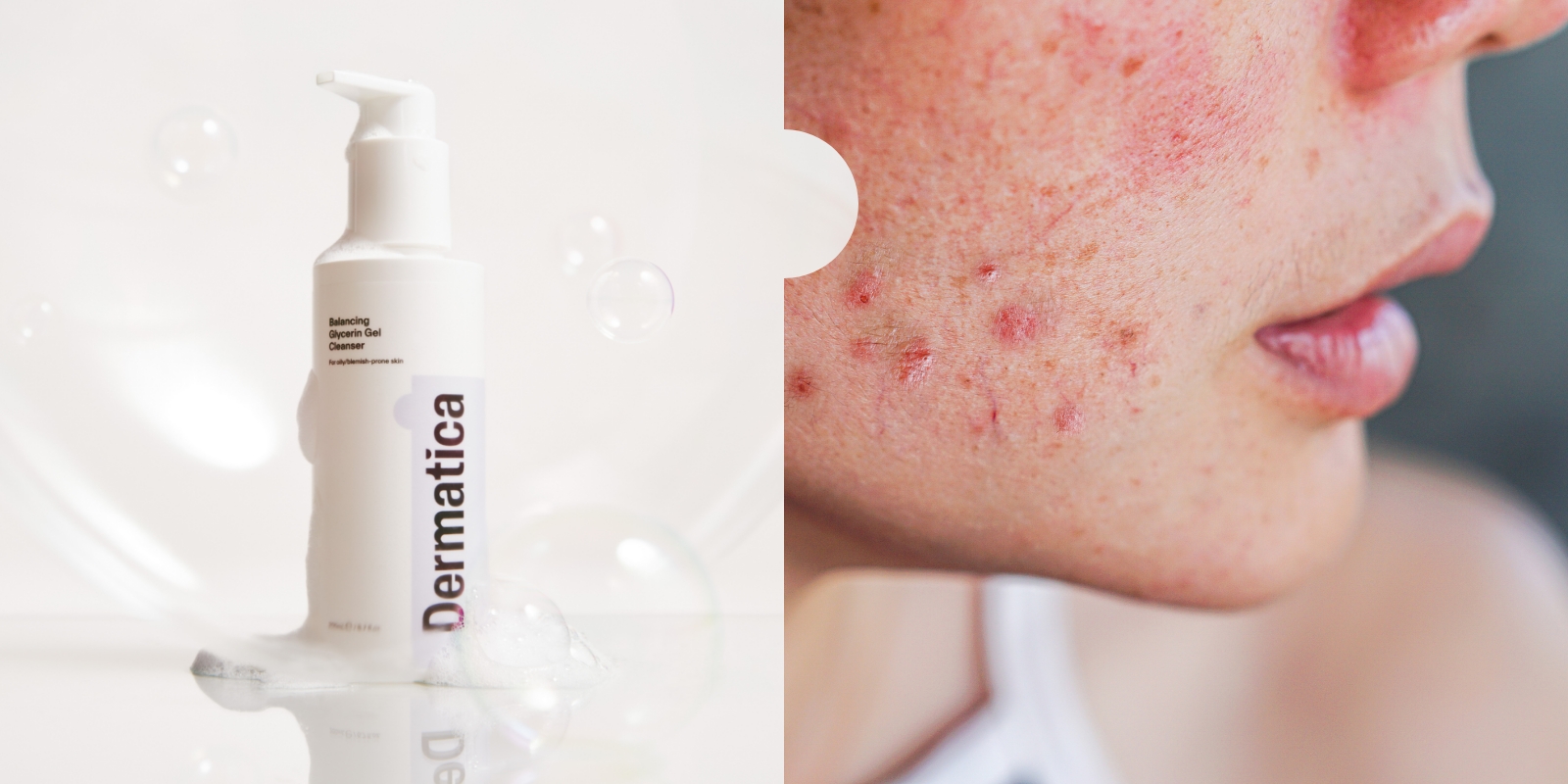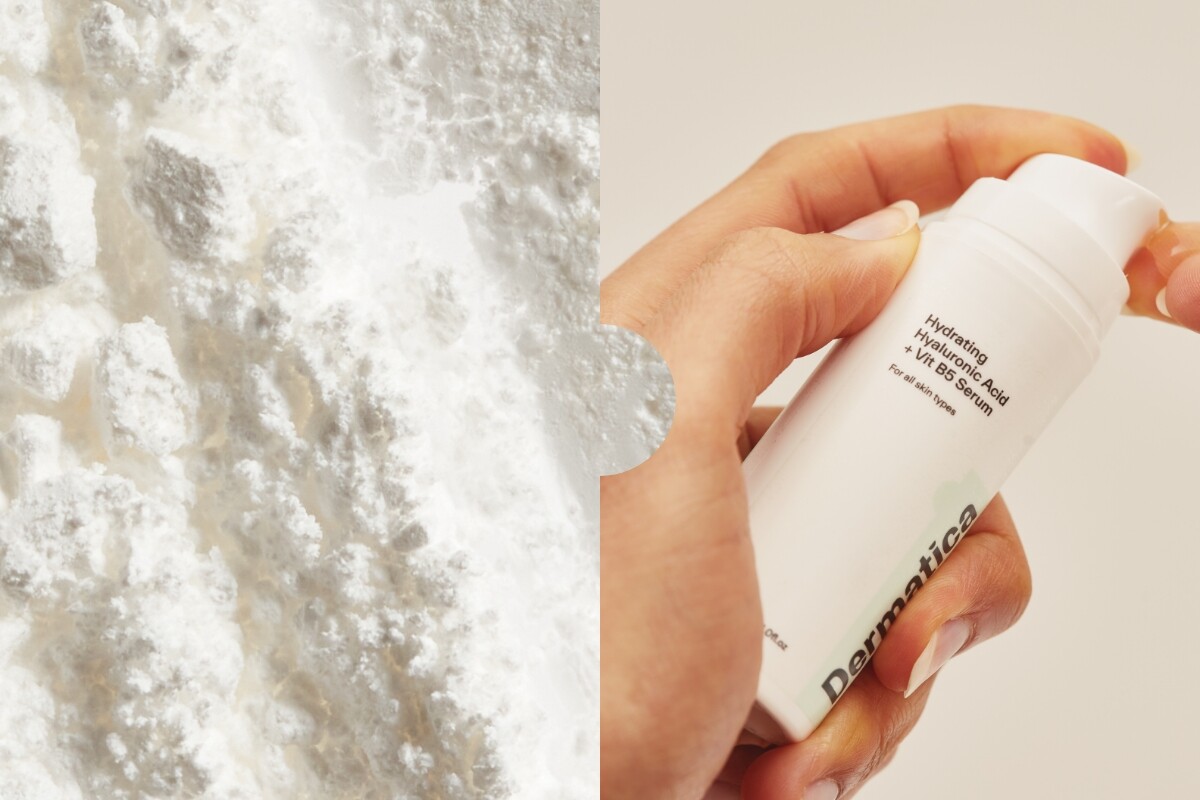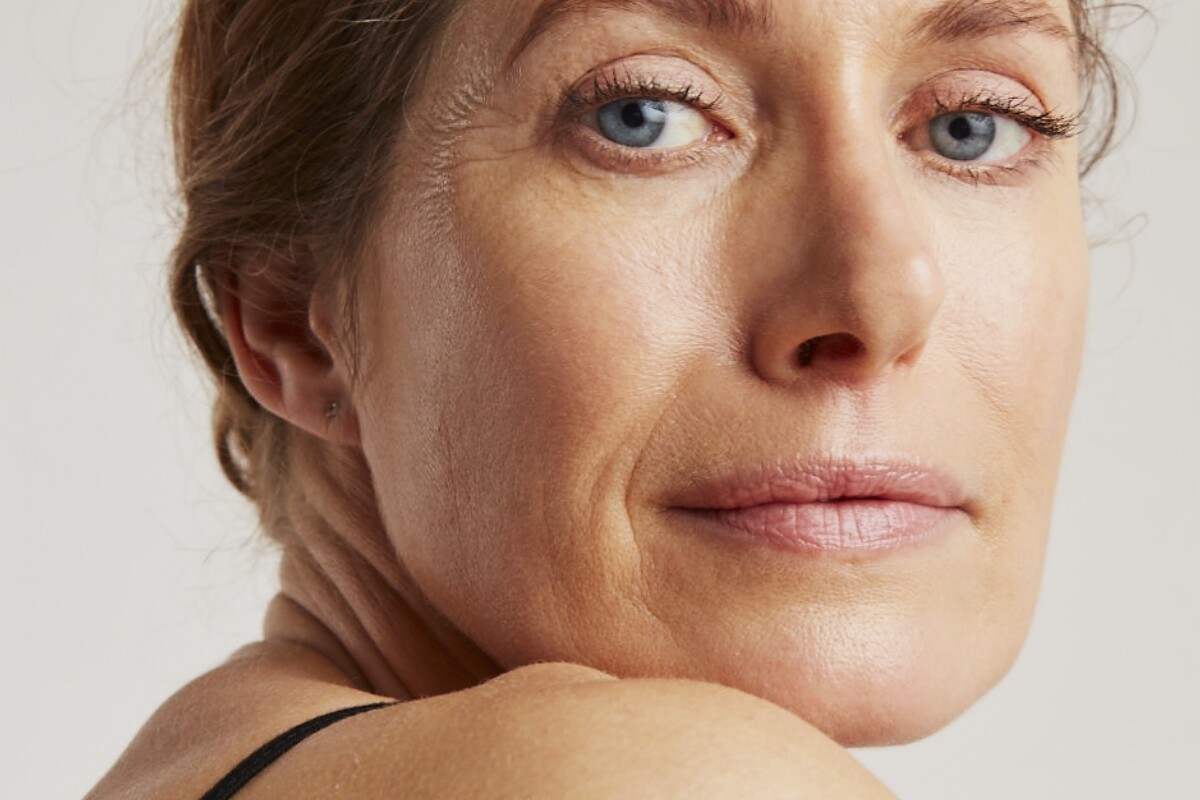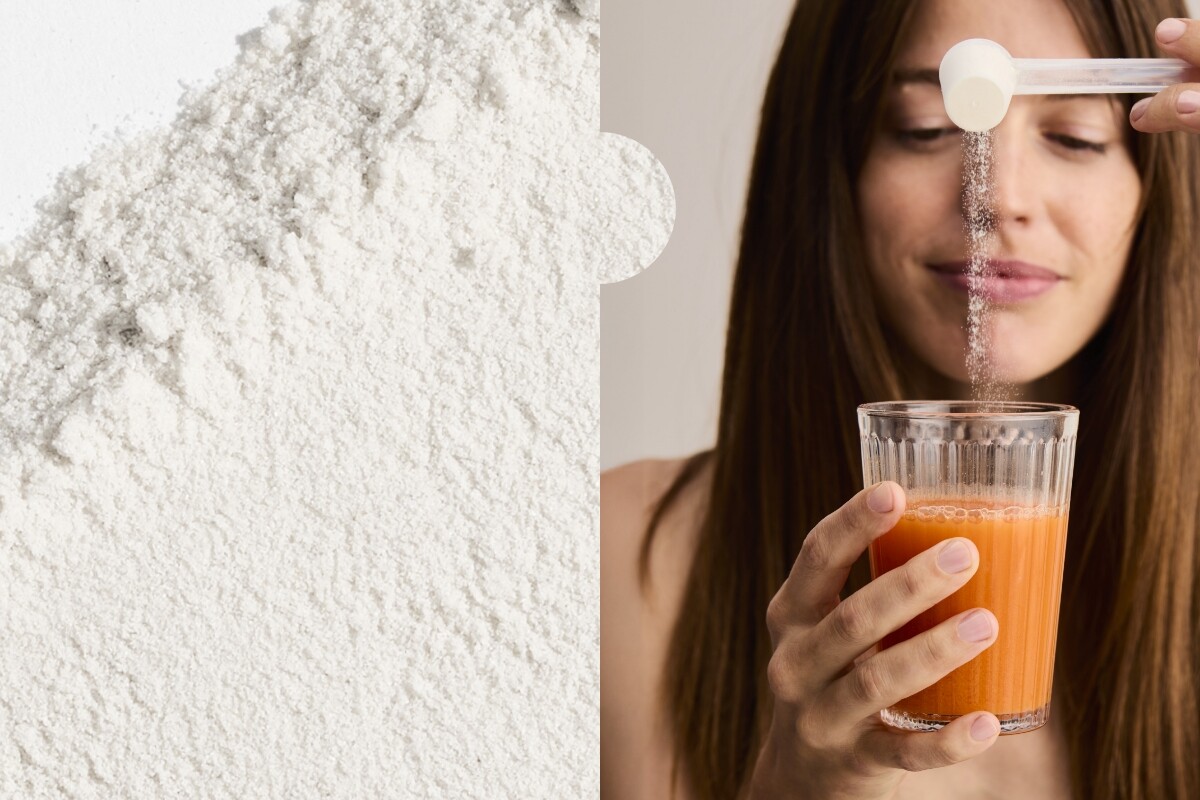Cheek acne is one of the most common areas that people experience breakouts. Thankfully there are many things you can introduce to your routine to help. When used consistently, our Dermatica customers have found science-backed treatments clear adult acne, fade post-inflammatory hyperpigmentation, prevent scarring and help keep breakouts at bay long term.
From triggers and common causes, to the correct cleansers, treatments and moisturisers, we’ll cover everything you need to know to help you deal with cheek acne as quickly as possible. You’ll also learn how to maintain the overall health of your skin.
Disclaimer: Trying to make all your breakouts clear overnight isn’t realistic or safe. Instead, this blog will show you ways to calm active breakouts safely, reduce their frequency and maintain clear skin, long term. Remember, patience is key. If you stay consistent, the results will be worth it.
What Causes Cheek Acne?
The location of this common skin condition can sometimes, but not always, indicate an underlying factor. However, the cause is always the same – it starts with excess sebum production, which eventually clogs the pores. (1)
Clogged pores lead to the formation of comedones (blackheads and whiteheads). When acne-causing bacteria comes into contact with these clogged pores, your skin produces an inflammatory response to fight it off – acne lesions that we commonly refer to as pimples, whiteheads and/or cysts. (2)
Hormonal acne is different. It’s caused by hormonal fluctuations and usually presents as a “U” shape around the mouth, lower jawline and chin. Cheek acne isn’t usually triggered by hormonal imbalances in your body in the same way. (3)
Why Do Some People Get Cheek Acne?
Having oily skin, the size of your pores, and the amount of sebum (oil) your skin produces, are all highly influenced by your genetics and your risk of acne.
Whether we have dry skin or oily skin, most of us also have larger pores and oil glands on our cheeks, so we’re more likely to get spots if there’s an excess of sebum production and acne-causing bacteria. (4)
Recommended Skincare To Get Rid Of Cheek Acne
There are products you can use – as well as ones you should avoid – to build an effective skincare routine for clearer skin.
However, if you have severe acne that doesn’t seem to go away, there’s nothing wrong with going straight to a dermatology expert for help. Especially if these acne flare-ups affect your mood or if you have prolonged skin inflammation, which can cause dark spots and acne scarring. Private consultant dermatologists can be expensive, and the NHS can have long wait times, so if that’s what’s stopping you, online services like Dermatica can assess your skin and tailor an affordable, personalised treatment for you safely and effectively.
Home remedies and DIY solutions should be avoided as these aren’t tested or regulated, and risk making your condition worse.
If your acne is mild to moderate, here’s how to build a skincare routine that won’t exacerbate your breakouts, as well as some professional tips to keep in mind.
The Best Routine For Acne On Cheeks
For proper acne care, a simple routine is best. This ensures you don’t overload your skin barrier with too many products and ingredients, which could stop your skin from improving or worsen your condition. These products can help reduce inflammation in the skin to reduce your risk of scarring and post-inflammatory hyperpigmentation.
– Step 1: Cleanse. Wash your face with warm water and a cleanser that’s fragrance free, oil free and non-comedogenic (won’t clog pores). Better still if it’s barrier-strengthening and formulated according to the NICE guidelines for sensitive skin, like our Balancing Glycerin Gel Cleanser.
– Step 2: Treat. This is your treatment or active ingredient step, and should only be used at night. If you need help finding a treatment that’s right for you, visit our website.
– Step 3: Moisturise. When you have active breakouts, nourishing and protecting your skin barrier is even more important. Find one that has a soothing formula and gel texture, with ingredients like hyaluronic acid, centella asiatica, ceramides and peptides. Not sure where to look? Try our Soothing Centella Gel Moisturiser.
Active Ingredients & Topical Treatments To Look For
First, let’s caveat this section by saying do not use all these active ingredients at once. Introduce them slowly, one by one, unless a dermatology professional gives you personalised advice that says otherwise. An aggressive skincare routine using too many spot treatments can actually make your condition worse. Although you can combine actives, you might not need to. They work well individually, too. (5)
Stop using the product if you notice stinging, rashes, swelling, sores, lingering irritation that lasts for longer than a week, or damage to your skin barrier. Remember, there’s no such thing as a good sting.
Now we’ve covered that, here are some of the best science-backed ingredients we use to treat mild to moderate acne.
– Niacinamide
– Retinoids, like adapalene or tretinoin
– Azelaic acid
– Benzoyl peroxide
– Salicylic acid
– Glycolic acid or lactic acid
These products can take a few weeks to see results, so your acne won’t completely clear overnight. However, they all have extensive research showing their effectiveness, and are suitable to use long term to maintain your results.
When To Consider Oral Antibiotics For Acne Treatment
After assessing your skin, a dermatology professional might recommend oral antibiotics alongside topical treatments for faster results.
Combining oral medication with a topical treatment can target multiple acne symptoms at once, helping to clear cystic acne faster than just using topical treatments on their own. Their powerful antimicrobial and anti-inflammatory effects can also reduce new breakouts, side effects like “purging”, and acne breakouts on your body – helping to get your active acne under control quickly.
Oral antibiotics are prescription medications that should only be recommended by licensed medical or dermatology professionals who have analysed your skin.
Ingredients To Avoid
Certain ingredients like heavy oils, waxes and petrolatum should be avoided on the face. Same goes for essential oils like tea tree oil, as all these ingredients can clog pores or cause skin irritation. If in doubt, look for skincare products designed by dermatologists with science-backed ingredients and evidence-based formulations.
A lot of people with acne are allergic to fragrances and perfumes in products too, so we recommend choosing fragrance-free skincare products just to be safe.
Ethanol alcohol is also a big no-no. This volatile ingredient was once popular in toners for acne-prone skin, but it can have a drying and irritating effect on the skin and disrupt the balance of your skin’s natural oils. However, if you see cetyl alcohol or cetearyl alcohol on an ingredients list, these aren’t a problem. They’re gentle, fatty alcohols that are suitable for sensitive skin and aren’t drying, harsh or irritating. (6)
Potential Lifestyle Changes
Some small tweaks to your lifestyle may also help reduce acne triggers. These include…
(Not) Touching Your Face
Though resting your cheeks on your hand can be tempting – and comfortable – it can also spread oil, dirt and bacteria from your fingers to your face.
Try to consciously save touching your face for cleansing, moisturising, sunscreen and makeup only – and always wash your hands thoroughly (for at least 30 seconds) first. (7)
Changing Your Makeup
Some makeup products can also cause cheek acne, as they may contain fragrances or comedogenic (pore clogging) ingredients. Look for formulas that are suitable for sensitive or acne-prone skin, avoid heavy foundations and cleanse twice every evening with clean hands before applying other products in your skincare routine. Double cleansing ensures you remove all makeup, debris and dirt from your face, which will prevent clogged pores. (8)
Red dyes, especially in blushers, have been found to be comedogenic – and could be one explanation why cheek acne is so common. Look for blushers that have a natural red pigment called carmine instead, as this is non-comedogenic. (9)
Cleaning Your Makeup Brushes
Repeated use of common makeup tools like beauty blenders, brushes and sponges are all magnets for attracting acne-causing bacteria, as well as dirt and dead skin cells. Left uncleaned, the bacteria can multiply and spread onto your blushes, bronzers and powders, too. To prevent this bacteria from building up, clean your brushes every 7 to 10 days using dedicated makeup brush cleansers, castile soap or clarifying shampoo. If you’re concerned your makeup brushes may be triggering breakouts, try using dedicated, fast-drying cleaning sprays between washes, too. (7)
Changing Your Pillow Cases Regularly
Although there’s no clear evidence that breakouts are caused by poor hygiene, saliva, sebum, microbes, dead skin cells and residue from hair products can collect on your pillowcase, so it’s worth changing them regularly to be safe. Washing and changing your pillowcases once or twice a week is popular advice to combat this, and following it can’t hurt.
Lowering Your Stress Levels
Easier said than done, right? While lowering stress isn’t as simple as snapping your fingers, it’s important for maintaining healthy hormone levels and your overall skin health. Increased stress levels lead to inflammation and a rise in androgen levels, which can then trigger more oil production in the skin. If you can, exercise and sleep more to help lower the amount of cortisol in your body. (10)
Can Diet Trigger Cheek Acne?
Some studies have noticed a link between their acne breakouts and foods like sugar, high GI (glycaemic index) and processed foods, and dairy. While this may be true in individual cases, studies have also shown that this isn’t the same for everyone. How skin reacts to different foods can vary greatly from person to person, so as consultant dermatologist Dr Thivi Maruthappu says, foods should be considered as potential triggers rather than causes. (11)
You can read more about the potential links between diet and acne here.
The expert-approved tips in this guide can help you navigate which products, ingredients and lifestyle changes are right for you. However, it’s important to treat acne based on your individual skin type and what it needs. Find out what formulas are suitable for your skin by visiting our website.
References
1. Ayer J, Burrows N. Acne: more than skin deep. Postgraduate Medical Journal [Internet]. 2006 Aug 1 [cited 2020 May 31];82(970):500–6. Available from: https://www.ncbi.nlm.nih.gov/pmc/articles/PMC2585707/
2. Xu H, Li H. Acne, the Skin Microbiome, and Antibiotic Treatment. American journal of clinical dermatology [Internet]. 2019 Jun 1;20(3):335–44. Available from: https://www.ncbi.nlm.nih.gov/pmc/articles/PMC6534434/
3. Bagatin E, Freitas THP de, Rivitti-Machado MC, Ribeiro BM, Nunes S, Rocha MAD da. Adult female acne: a guide to clinical practice. Anais Brasileiros de Dermatologia [Internet]. 2019 Feb;94(1):62–75. Available from: https://www.ncbi.nlm.nih.gov/pmc/articles/PMC6360964/
4. Zhang H, Zhang Z. Genetic Variants Associated with Acne Vulgaris. International Journal of General Medicine. 2023 Aug 1;Volume 16:3843–56.
5. Kleemann J, Cinatl J, Hoffmann S, Zöller N, Özistanbullu D, Zouboulis CC, et al. Alcohol Promotes Lipogenesis in Sebocytes-Implications for Acne. Cells [Internet]. 2024 Feb 11 [cited 2024 May 25];13(4):328. Available from: https://pubmed.ncbi.nlm.nih.gov/38391942/
6. Dréno B, Bettoli V, Araviiskaia E, Sanchez Viera M, Bouloc A. The influence of exposome on acne. Journal of the European Academy of Dermatology and Venereology. 2018 Feb 15;32(5):812–9.
7. Spille JL, Grunwald M, Martin S, Mueller SM. Stop touching your face! A systematic review of triggers, characteristics, regulatory functions and neuro-physiology of facial self touch. Neuroscience & Biobehavioral Reviews. 2021 Sep;128:102–16.
8. Suh D, Oh H, Lee SJ, Kim HJ, Ryu HJ. Relationship between acne and the use of cosmetics: Results of a questionnaire study in 539 Korean individuals. Journal of Cosmetic Dermatology. 2020 Nov 30;20(7):2172–8.
9. Fulton JE, Pay SR, Fulton JE. Comedogenicity of current therapeutic products, cosmetics, and ingredients in the rabbit ear. Journal of the American Academy of Dermatology. 1984 Jan;10(1):96–105.
10. Zari S, Alrahmani D. The association between stress and acne among female medical students in Jeddah, Saudi Arabia. Clinical, Cosmetic and Investigational Dermatology. 2017 Dec;Volume 10(1):503–6.
11. Meixiong J, Ricco C, Vasavda C, Ho BK. Diet and acne: A systematic review. JAAD International. 2022 Jun;7:95–112.
Ash Sharma
Dr Ashwin Sharma is a medical doctor and writer with a particular interest in health technology, artificial intelligence and medical weight loss. He completed his training at the University of Leicester and Imperial College London, and has since been exploring the intersections of medicine, technology, and communication.





